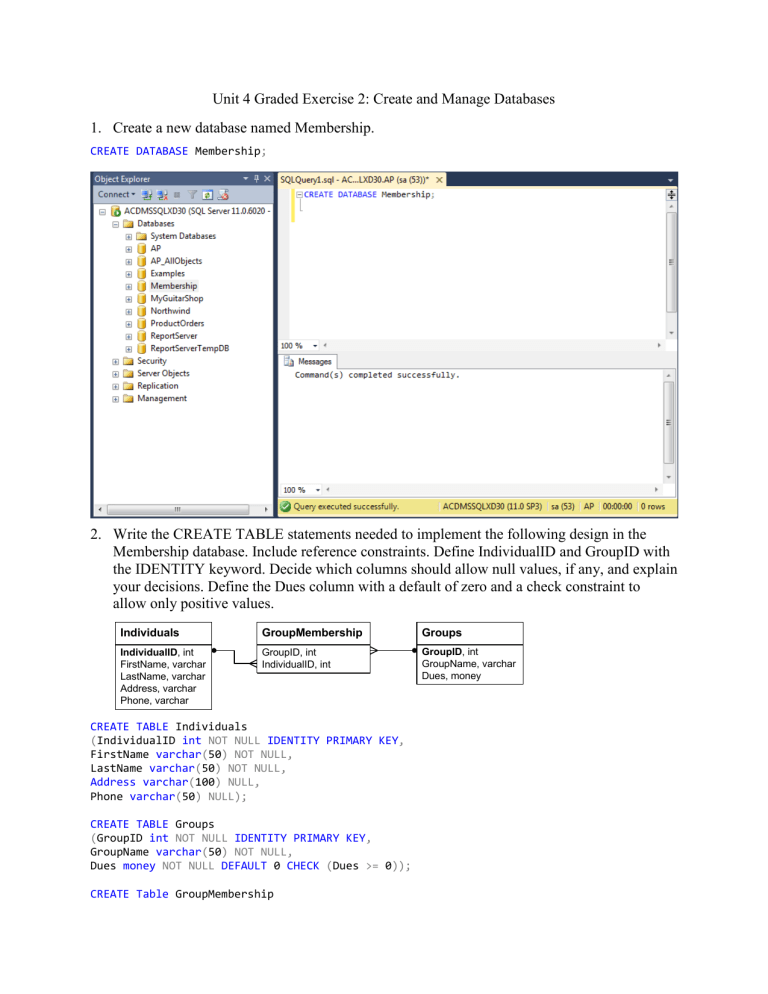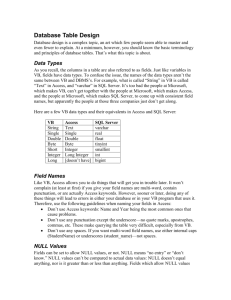
Unit 4 Graded Exercise 2: Create and Manage Databases 1. Create a new database named Membership. CREATE DATABASE Membership; 2. Write the CREATE TABLE statements needed to implement the following design in the Membership database. Include reference constraints. Define IndividualID and GroupID with the IDENTITY keyword. Decide which columns should allow null values, if any, and explain your decisions. Define the Dues column with a default of zero and a check constraint to allow only positive values. Individuals GroupMembership Groups IndividualID, int FirstName, varchar LastName, varchar Address, varchar Phone, varchar GroupID, int IndividualID, int GroupID, int GroupName, varchar Dues, money CREATE TABLE Individuals (IndividualID int NOT NULL IDENTITY PRIMARY KEY, FirstName varchar(50) NOT NULL, LastName varchar(50) NOT NULL, Address varchar(100) NULL, Phone varchar(50) NULL); CREATE TABLE Groups (GroupID int NOT NULL IDENTITY PRIMARY KEY, GroupName varchar(50) NOT NULL, Dues money NOT NULL DEFAULT 0 CHECK (Dues >= 0)); CREATE Table GroupMembership (GroupID int REFERENCES Groups(GroupID), IndividualID int REFERENCES Individuals(IndividualID)); 3. Write the CREATE INDEX statements to create a clustered index on the GroupID column and a nonclustered index on the IndividualID column of the GroupMembership table. CREATE CLUSTERED INDEX IX_GroupMembership_GroupID ON GroupMembership(GroupID) CREATE INDEX IX_GroupMembership_IndividualID ON GroupMembership(IndividualID); 5. Write an ALTER TABLE statement that adds two new check constraints to the Invoices table of the AP database. The first should allow (1) PaymentDate to be null only if PaymentTotal is zero and (2) PaymentDate to be not null only if PaymentTotal is greater than zero. The second constraint should prevent the sum of PaymentTotal and CreditTotal from being greater than InvoiceTotal. ALTER TABLE Invoices ADD CHECK ((PaymentDate IS NULL AND PaymentTotal = 0) OR (PaymentDate IS NOT NULL AND PaymentTotal > 0)), CHECK ((PaymentTotal + CreditTotal) <= InvoiceTotal); 1. Use the Management Studio to create a new database called Membership2 using the default settings. (If the database already exists, use the Management Studio to delete it and then recreate it.) CREATE DATABASE Membership2; 2. Use the Management Studio to create the following tables and relationships in the Membership database. Define IndividualID and GroupID as IDENTITY columns. Allow Address and Phone to accept null values; none of the other columns should allow null values. Define the Dues column with a default of zero and a check constraint to allow only positive values. Define the DuesPaid column with a default Boolean value of False. Individuals GroupMembership Groups IndividualID, int FirstName, varchar LastName, varchar Address, varchar Phone, varchar DuesPaid, bit GroupID, int IndividualID, int GroupID, int GroupName, varchar Dues, money CREATE TABLE Individuals (IndividualID int NOT NULL IDENTITY PRIMARY KEY, FirstName varchar(50) NOT NULL, LastName varchar(50) NOT NULL, Address varchar(100) NULL, Phone varchar(50) NULL, DuesPaid bit NOT NULL DEFAULT 0); CREATE TABLE Groups (GroupID int NOT NULL IDENTITY PRIMARY KEY, GroupName varchar(50) NOT NULL, Dues money NOT NULL DEFAULT 0 CHECK (Dues >= 0)); CREATE Table GroupMembership (GroupID int REFERENCES Groups(GroupID), IndividualID int REFERENCES Individuals(IndividualID)); 3. Use the Management Studio to index the GroupMembership table. Create a clustered index on the GroupID column, a nonclustered index on the IndividualID column, and a unique index and constraint on both columns. CREATE CLUSTERED INDEX IX_GroupMembership_GroupID ON GroupMembership(GroupID); CREATE INDEX IX_GroupMembership_IndividualID ON GroupMembership(IndividualID); CREATE UNIQUE INDEX AK_GroupID_IndividualID ON GroupMembership(GroupID, IndividualID);




